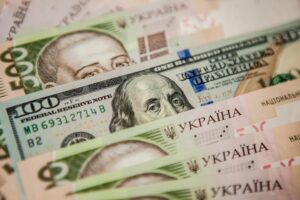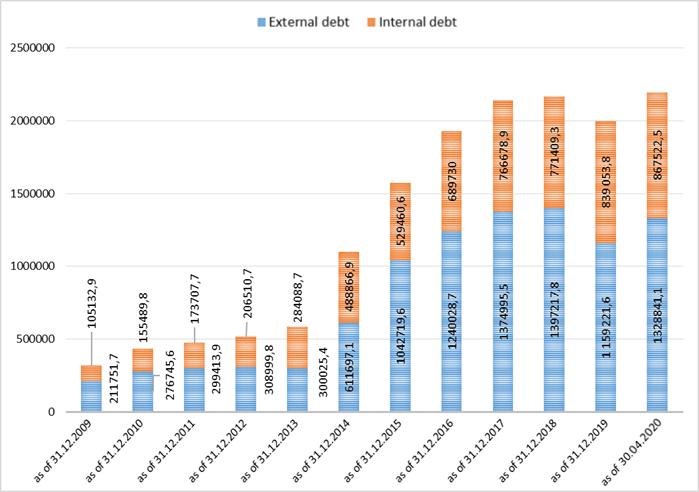
The total public debt of Ukraine in April 2021 increased by 1.29% in U.S. dollars to $91.33 billion and by 0.8% in hryvnias, to UAH 2.534 trillion, according to data on the website of the Ministry of Finance, released on Wednesday.
According to the Ministry of Finance, direct public debt in April this year in U.S. dollars grew by 1.53%, to $81.37 billion, in hryvnias – by 1.04%, to UAH 2.258 trillion.
External direct debt in the past month in U.S. dollars rose by 3.89%, to $45.12 billion (in hryvnias growth was 3.38%, to UAH 1.251 trillion).
The state-guaranteed debt in April in U.S. dollars decreased 0.7% to $9.95 billion, in hryvnias decreased 1.17%, to UAH 276.25 billion, according to the ministry’s data.
According to them, since the beginning of the year, the total national debt of Ukraine has grown by 1.19% in U.S. dollars and by 18.33% in hryvnias.
According to the Ministry of Finance, the share of liabilities in U.S. dollars of the total structure of public debt in April increased to 36.15%, in euros – to 13.68%, in SDR – to 13.54%, while in hryvnias it decreased to 36.02% , while in the yen it remained at the same level – 0.6%.
The official exchange rate, at which the Ministry of Finance calculates the debt, strengthened to UAH 27.75/$1 in April compared to UAH 27.88/$1 in March.
Internal and external debt of Ukraine in 2009-2020.

SSC of Ukraine
Internal and external debt of Ukraine in 2009-2020.

Source: SSC of Ukraine
Internal and external debt of Ukraine in 2009-2020

Ukraine’s gross external debt by the end of March 2020 amounted to $120.33 billion, which is $1.41 billion, or 1.2% less than a quarter earlier, the National Bank of Ukraine (NBU) has said.
According to his data, in relation to GDP, the debt decreased from 78.6% to 76%.

The total state debt of Ukraine in January 2020, due to the weakening of the hryvnia exchange rate by 5.2%, in U.S. dollar terms decreased by 1.1%, or by $940 million, to $83.43 billion, the Finance Ministry has said.
According to its data, at the same time, this devaluation led to an increase in the national debt in hryvnias by 4%, or by UAH 80.72 billion, to UAH 2.079 trillion.
The Ministry of Finance noted that in January it held three auctions for the placement of government domestic loan bonds, at which it raised UAH 18.5 billion at the rates that by the end of the month fell below 10% per annum, and also placed eurobonds for EUR 1.25 billion at 4.375%.
State budget expenditures for the repayment of public debt in January 2020 amounted to UAH 31.6 billion, for servicing some UAH 4.4 billion.
In January, the share of obligations in dollars in the general structure of the state debt of Ukraine decreased from 38.9% to 38.5%, in hryvnias from 36.7% to 35.25%, while in euros it increased from 10.2% to 11.85%.